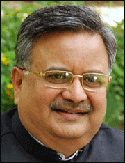 EXCLUSIVE INTERVIEW WITH DR. RAMAN SINGH, CHIEF MINISTER OF CHHATTISGARH
EXCLUSIVE INTERVIEW WITH DR. RAMAN SINGH, CHIEF MINISTER OF CHHATTISGARH
It’s been around eight years since you took charge as Chief Minister of Chhattisgarh. What are your achievements and your long-term vision for the economic, industrial and infrastructure development of the state?
In the last eight years I have tried to change the image of the state from a backward and sick state to a fastest developing state. In many sectors Chhattisgarh has become the model state of India. Good governance, good infrastructure, attractive policy framework for investors and people-oriented development schemes have bettered so many things in the state. You will be amazed to know that Chhattisgarh has achieved the highest GSDP rate amongst all the states. It has emerged as the most favourite destination for investors. We have planned to make our state an investor friendly as well as people friendly state. We have planned to increase the standard of living and per capita income and achieve all the indicators for human development. We are striving to make Chhattisgarh the most developed state in India in the next decade.
What are your plans to increase the growth rate of your state during the ongoing 12th Plan period?
There are certain norms to scale the growth of the state. You will be happy to know that we are maintaining double-digit growth rate at least for the last seven years. A remarkable growth rate was registered in 2009-10. In that year the Gross State Domestic Product rate was 11.49 per cent, which was the highest amongst all the state. The average GSDP growth rate of past seven years was around 11 per cent.
In 2010-11, Chhattisgarh again showed the strength of its vision, policies, programmes and schemes. Sustainable environment of development has increased the GSDP growth rate in 2010-2011 over 2009-2010.
This year Chhattisgarh was in the top most three state i.e. Bihar (14.79 per cent), Tamil Nadu (11.74 per cent) and Chhattisgarh (11.57 per cent). The most significant development in the state was moving ahead from 11.49 per cent last year to 11.57 per cent which is considered a phenomenal success.
Our plan expenditure has increased seven times from 2004-05 to 2011-12 while nonplan expenditure has increased only 3 per cent. In 2012-13, the plan expenditure of Chhattisgarh will be 54 per cent whereas the Government of India’s plan expenditure will be only 35 per cent. This shows to what extent we are going to promote our infrastructure sector. Our capital expenditure is going to increase from 15 per cent to 19 per cent.
Good quality roads and highways are essential to development of every state. Tell us about your government’s initiatives in road infrastructure, especially in rural areas?
When the state was formed (on November 1, 2000), the density of roads was 17.5 km per 100 sq. km, which has increased to 21.40 km through various efforts.
Apart from the general schemes, we have launched special schemes for the villages. We have launched the Chief Minister Gram Sadak Yojana in those habitats that do not come under the Pradhan Mantri Gram Sadak Yojana. About 4,100 km of roads have been proposed under this scheme at a cost of Rs.2,000 crore. We wish to touch the national average soon in road construction.
Around 4,000 km of rural roads will be upgraded to bituminous-tar roads and another 500 km of internal village roads will be upgraded to cement-concrete road.
Under the Chhattisgarh State Road Sector Development Project: 1,175 km of major district roads and state highways were upgraded with ADB assistance in phase-I and 935 km of MDR/state highways will be undertaken in phase-II (2012- 14).
How do you intend to make your government’s policies more industry friendly and attract greater industrial investment?
Chhattisgarh has immense potential for prospecting, exploration and exploitation of minerals for industrial use and export. Deposits of diamonds and gemstones, iron ore, coal, limestone, dolomite, gold, tin ore (casseterite), bauxite poly-metallic ores stones etc. of Chhattisgarh are well known the world over.
Chhattisgarh has abundant mineral resources; we have 28 types of minerals. We have 16 per cent of India’s mineral production, worth more than Rs.90 billion annually. Chhattisgarh has mainly iron ore – 2,731 million tonnes (18.67 per cent of the country), coal – 44,483 million tonnes (16.65 per cent) and dolomite – 847 million tonnes (11.24 per cent of the country).
Our policy promotes only such investors who are interested in value addition in our state. We have a policy for sustainable development in this sector. We have thus attracted huge investments in iron and steel, energy, cement and aluminium industries.
Now also we have vast opportunities in downstream industries, agro and herbal industries, information technology industries, services sector etc.
We are providing many concessions and subsidies to our thrust sectors: a peaceful atmosphere and skilled manpower. The many industrial training institutes are a major support to upcoming industries. Sufficient power and growing quality of educational institutions are additional attractions.
The ambitious Rs.4,500-crore rail corridor project in Chhattisgarh was recently cleared, thus paving the way for a government owned SPV. Can you tell us more about this project?
Poor railway connectivity is a major hurdle for development of tribal areas of our state. So we plan to develop three corridors to cover the north-east and east-west parts of the state. This development will help boost various economic activities, public transportation and industrialisation. The main features are: three railway corridors on PPP model with Ministry of Railways, SECL and the Chhattisgarh government, namely Eastern Corridor (180 km) (Bhupdevpur- Gharghoda-Korba), Northern Corridor (150 km) (Surajpur-Katghora-Korba) and East- West Corridor (122 km) (Gevra Road-Katghora- Pendra Road).
The total length of the three corridors is 452 km with an estimated cost of Rs.6,000 crore and is 38 per cent of existing lines.
The approvals of the Chhattisgarh government and Government of India have been obtained and work will start soon.
What is the scenario of the power sector in Chhattisgarh?
Actually, Chhattisgarh has been a backward state for various historical and geographical reasons. We had crises in electricity, roads, drinking water, housing and other sectors. Breaking the deadlock of over two decades in the power sector, we established two thermal power plants of 500 MW capacity. Simultaneously, we decided to make Chhattisgarh a power hub.
At the time of the state’s formation (in 2000) the total power generation capacity was 1,360 MW, which went up to 1,925 MW by the end of the 11th Five-Year Plan. A couple of new power plants with a collective capacity of 1,500 MW are nearing completion.
Moreover, some more power plants, with a total capacity of 30,000 MW, would be installed during the 12th Five-Year Plan.
We have targeted to contribute more than 30 per cent of the country’s total power generation by end of the 12th Plan. The infrastructure is being developed accordingly for the distribution and transmission of the expected capacity of power generation.
Because of such initiatives, we have already become one of the few states in India with 24- hour power supply. That is why our per consumer electricity consumption has gone up from 354 units to 1,547 units, which is one of the highest in the country.
Can you briefly talk about Naya Raipur, the new state capital?
Chhattisgarh is on the way to developing its new state capital, Naya Raipur, the fourth new capital city in the country (and first in the 21st century) after Chandigarh, Gandhi Nagar and Bhubaneswar. Its total area is 8,000 hectares. Its major features are ecofriendly city with large parks, water bodies, jungle safari and botanical garden.
A bus rapid transit system (BRTS) is under implementation with World Bank aid and support under the Jawaharlal Nehru National Urban Renewal Mission (JNNURM). The entire city would have only underground electric cables.
The state administrative capital, Mantralaya, is planned to be shifted from November 1, 2012.











